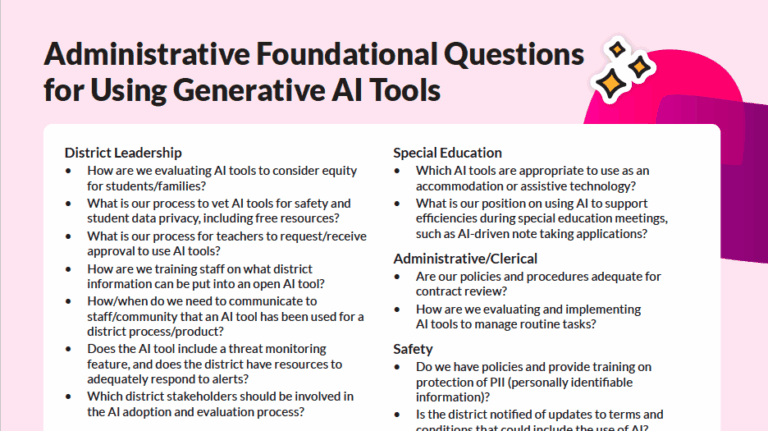The barriers that keep female leaders from maximizing their true potential
By Heather Vennes, Ed.D.
The startling realization that women make up two-thirds of the teaching profession nationwide but only one-third of the superintendency illuminates an urgency to explore the barriers that prevent females from reaching top educational leadership positions.
Although 75 percent of the educational workforce nationwide is comprised of females, only 23 percent of top educational leadership positions are held by female educators (Institute of Education Sciences, 2020). This discrepancy creates a paradox, as women disproportionately hold more teaching positions, but men continue to control the majority of upper-level administrative positions (Wickham, 2007). While women are overrepresented as classroom teachers nationwide, they continue to be underrepresented in leadership positions despite recent increases in the percentage of women serving as superintendent and as elementary principals (Kerr, Kerr & Miller, 2014).
The incongruity of females serving in leadership roles has been at the forefront of research surrounding women and educational leadership as early as the 1980s. Judith Adkison (1981) attributed the absence of female leaders to gender inequality, lack of mobility, stereotypes surrounding successful managerial qualities and leadership behaviors described using masculine terms. Although women have made progress in gender equality and representation in administrative positions within the last decade, with the current rate of growth it is projected to take at least another 30 years for women to gain parity with their male counterparts nationwide (Munoz, Pankake, Ramalho, Mills & Simonsson, 2014).
Despite numerous social, structural and perceptual barriers that affect the leadership progression of women in the workplace, personal barriers can also explain the continued gap between the career development and upward mobility of men and women in educational leadership. These personal barriers are known as self-sabotaging behaviors and can be classified within nine domains that affect women’s personal power and prevent them from reaching their true leadership potential.
The top self-sabotaging behaviors that prevent female leaders from maximizing their potential can include (adapted from Ryder & Briles, 2003):
Thinking too small: This self-sabotaging behavior occurs when women minimize their personal value, they do not have the courage to step outside of their comfort zone to pursue leadership opportunities, or they feel that they must meet all qualifications of a leadership position before they can even apply.
Fear and worrying: This self-sabotaging behavior may cause women to feel anxious or concerned about changing positions, cause them to feel like an imposter on the job, or to fear rejection, all of which may prevent women from applying for leadership positions altogether.
Misunderstanding one’s self: Women who do not accept compliments or seek out feedback can sabotage their progression into leadership positions as they are not willing to highlight the strengths and assets that they bring to the table or make necessary changes in their leadership style.
Dishonesty: This self-sabotaging behavior occurs when women choose to be nice to avoid confrontation or they choose to stay quiet when it would be best to speak up. This behavior does not allow women the opportunity to share the knowledge and expertise that they can bring to leadership positions.
Holding back: This occurs when women avoid criticism, apologize unnecessarily, or are insecure about balancing work and family obligations. Holding back is a self-sabotaging behavior that causes women to appear indecisive or unconnected to their leadership aspirations and goals.
Not taking time for reflection: This self-sabotaging behavior occurs when women do not allow themselves any down time or feel that they need to work more than their peers to prove they are worthy of leadership positions.
Isolation: This self-sabotaging behavior occurs when women are unaware of the types of support they need or they only network upstream. When women are not connecting with powerful networks, they are missing out on possible leadership opportunities and sponsorships.
Disempowering other women: This self-sabotaging behavior can cause women to feel jealous of other women who have made it or cause them to be harder on their female subordinates. This self-sabotaging behavior affects all women in the workplace, as it creates unnecessary barriers for both female leaders and subordinates.
Infusing sex/gender role confusion in the workplace: This self-sabotaging behavior occurs when women feel pressure to squash natural feminine qualities or to conform to societal gender roles such as cleaning up or taking notes, which do not provide women with the opportunity to highlight their true leadership capacity.
Although women have the training, experience and credentials to fulfil the requirements for upper-level administrative positions, societal beliefs, gender expectations and biased leadership selection processes continue to affect women’s ability to successfully enter these positions (Bernal, Mosonov, Stencler, Lajoie, Raigoza, Akhavan, 2017). The gender gap in educational leadership is often attributed to social factors without concentrating on the internal, self-sabotaging factors that are affecting potential female leaders. Women can be unwilling to pursue leadership positions or tasks due to a lack of self-confidence in their ability or skillset. This lack of confidence stems from research suggesting that women are viewed as less effective leaders because men are viewed as better decision-makers. Desired masculine leadership characteristics, such as assertiveness and emotional stability, are viewed negatively when employed by women (Dickerson & Taylor, 2000). Additionally, job descriptions for superintendents often relate directly to the experiences and backgrounds of white males; therefore, women’s leadership attributes and experiences fall outside of the norms and characteristics used to describe a successful superintendency, and qualities such as being rational or collaborative are related to teaching, not leadership, positions (Brunner, 2003). Because women are more likely to face gender bias and stereotypes from their school board and local communities, they often believe that they must accept leadership positions in smaller districts or districts with challenges in order to have the opportunity to assume a leadership position (Bollinger & Grady, 2018).
Limited mobility, lack of strong mentors and role models, family responsibilities and gatekeeping also play a role in limiting women’s access to the superintendency (Adkison, 1981; Mahitvanichacha & Rorrer, 2006). Many of these barriers include internal aspects, such as lack of confidence or self-efficacy, guilt, or pressure to manage family responsibilities, or a focus on positions that are not a direct pathway to the superintendency. Finding strategies to overcome internal barriers is one of the most important components of addressing the gender gap that exists within educational leadership positions.
In order to truly address the gender gap in educational administration, while also being mindful of the self-sabotaging behaviors that female leaders may face, the following implications for action are suggested:
- Current and aspiring male and female educators should be aware of self-sabotaging behaviors and how these affect aspiring female leaders in their career development and progression.
- Female leaders and aspiring leaders should access professional groups and organizations to support their leadership career growth and progression. These groups and organizations should be well-versed in self-sabotaging behaviors, their effects and how they can be overcome.
- Information about self-sabotaging behaviors and specific strategies to identify and overcome gender-based mindsets should be built into career awareness and workforce readiness programs for young women.
- Current female leaders must utilize information about the effects of self-sabotaging behaviors and related strategies as they coach and/or mentor aspiring female leaders.
- University preparation and credentialing programs should expose aspiring teachers and administrators to research and information about self-sabotaging behaviors, how women can effectively overcome these behaviors, and how these behaviors affect female leadership progression.
Because the construction of the norms of the superintendency often relate to the experiences and backgrounds of male candidates, discourse surrounding the superintendency focuses on the male voice and perspective. These constructions are inherently exclusionary as women’s experiences are often omitted, leaving women’s voice out of the discussion of the norms or standards for the superintendency (Brunner, 2003). Ensuring that women’s lived experiences and voices are included in the narrative of the superintendency is one of the largest inconsistencies in current research. Empowering and encouraging women to pursue leadership positions involves changing this narrative and its masculine focus, providing women with strong role models and networks, and focusing on the importance and relevance of the transformational leadership qualities that women bring to the table.
Understanding and recognizing self-sabotaging behaviors is an integral step in narrowing the gender gap in educational leadership. Only 26.9 percent of current superintendents nationwide are women and, interestingly, women are choosing not to apply for the superintendency despite being some of the most qualified candidates for this position (Ramaswamy, 2020; Starr, Ng, Rogers & Tienken, 2020; The School Superintendents Association, 2020). Aspiring female leaders are faced with external barriers, such as gender stereotypes and implicit bias in the workplace, as well as self-imposed, self-sabotaging barriers, such as lack of confidence and decreased access to networking and strong female mentors, which negatively impact their career advancement (Ryder & Briles, 2003). It is imperative that women’s self-imposed barriers are recognized by the larger school community in order to narrow the historically significant gender gap in the superintendency and allow women access to the upper-level management positions for which they are qualified.
References
Adkison, J. A. (1981). Women in school administration: A review of the research. Review of Educational Research, 51(1), 311-343.
Bernal, C., Monosov, N., Stencler, A., Lajoie, A., Raigoza, A., & Akhavan, N. (2017). Gender bias within the superintendency: A comparative study. Journal of School Administration Research and Development, 2(1), 42-52.
Bollinger, A. A., & Grady, M. L. (2018). Women’s satisfaction in the superintendency: A mixed methods study. Leadership and Research in Education, 4, 46-69.
Brunner, C. C. (2003). Invisible, limited, and emerging discourse: Research practices that restrict and/or increase access for women and persons of color to the superintendency. Journal of School Leadership, 13, 428-450.
Dickerson, A., & Taylor, M. A. (2000). Self-limiting behaviors in women: Self-esteem and self-efficacy as predictors. Group & Organization Management, 25(2), 20.
Institute of Education Sciences. (2020). Characteristics of Public and Private Elementary and Secondary School Teachers in the United States. Retrieved from https://nces.ed.gov/pubs2020/2020142.pdf.
Kerr, B., Kerr, G. R., & Miller, W. (2014). Bureaucratic, leadership, and workforce representation among female administrators, principals, assistant principals, and classroom teachers in U.S. school districts, 2002-2008. Public Administration Quarterly, 38(3), 371-404.
Mahitivanichacha, K., & Rorrer, A. K. (2006). Women’s choices within market Constraints: Re-visioning access to and participation in the superintendency. Educational Administration Quarterly, 42(4), 483-517.
Munoz, A. J., Pankake, A., Ramalho, E. M., Mills, S., & Simonsson, M. (2014). A study of female central office administrators and their aspirations to the superintendency. Educational Management Administration and Leadership, 42(5), 764-784.
Ramaswamy, S. V. (2020, February 20). Superintendents are overwhelmingly male. What’s holding women back from the top job? USA Today. Retrieved from https://www.usatoday.com/story/news/education/2020/02/20/female-school-district-superintendents-westchester-rockland/4798754002/.
Ryder, M., & Briles, J. (2003) The SeXX factor: Breaking the codes that sabotage personal and professional lives. Far Hills, N.J.: New Horizon Press.
Starr, J., Ng. N. E., Rogers, C. & Tienken, C. H. (2020). AASA Releases Key Findings From the American Superintendent 2020 Decennial Study. Retrieved from https://www.aasa.org/content.aspx?id=740.
The School Superintendents Association [AASA]. (2020). The Study of the American Superintendent: 2015 Mid-Decade Update Summary of Findings. Retrieved from https://aasa.org/uploadedFiles/Policy_and_Advocacy/files/AASA%20Mid- Decade%20Summary%20of%20Findings.pdf.
Wickham, D. M. (2007). Female superintendents: Perceived barriers and successful strategies used to attain the superintendency in California (Doctoral dissertation). Retrieved from ProQuest Dissertations and Theses database. (UMI No. 3298429)




































